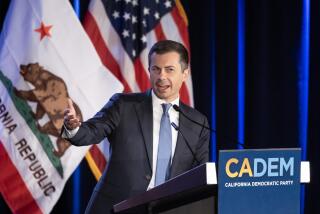SOUTHERN CALIFORNIA ENTERPRISE : Looking Out for California’s Small Businesses : Conference: State’s delegation, the Washington gathering’s largest, aims to protect funding, other interests.
- Share via
WASHINGTON — Patty Shaw, chief financial officer of a Torrance technology firm that bends light for communication purposes, is in the nation’s capital today with a goal.
As a California delegate to and exhibitor at the White House Conference on Small Business, Shaw wants to ensure that small high-tech companies don’t get lost among the 1,790 delegates and 90 exhibitors expected here this week.
Technology-based firms such as hers have banded together to push for their concerns, chief among them the preservation of life-giving federal research funds for small businesses.
The third congressionally funded small business convention begins today at the Washington Hilton and Sheraton Washington hotels. It has attracted not only representatives like Shaw, from whole new industries, but also major corporations eager to sell products to growing new businesses.
Some mega-firms like IBM--eager to win business from small business--have sent their top executives. A few have helped state delegations with receptions and lobbying materials, and others are part of an oversubscribed exhibit hall showcasing new business products and services. Members of Congress have invited entire delegations to their offices to chat. President Clinton and Securities and Exchange Commission Chairman Arthur Levitt are among the speakers.
The high-level activity signals that small businesses have attained new levels of commercial clout and political recognition.
The conference will provide legislative cues for the White House and Congress for the next decade, and the 167-strong California delegation, the largest group at the conference, expects to play a prominent role.
“I believe California is more visionary, thinking farther ahead than other delegations, especially with technology,” said Betty Jo Toccoli, chair of the Southern California delegation and owner of an employee-benefit planning company in Marina del Rey.
Issues of special interest to California small businesses, Toccoli said, include proposals to help foster international trade, provide transition aid for those affected by military base closures, win immigration reform, keep affirmative action and allocate more federal research and development money to small businesses.
Federal research money has been vital to the success of Physical Optics, the company where Shaw works. The 11-year-old firm began operating out of a Redondo Beach garage after founders Joanna and Tomaz Jannson defected from Poland with $100 in cash. With grants and contracts from several federal agencies funneled through the Small Business Innovation Research Program and funding from several federal agencies, the company has expanded to two buildings in Torrance and 100 employees, 28 of them with doctorates. Sales are expected to reach $11.5 million this year, Shaw said.
With the help of federal money, the company has created holographic systems to make filters for flashlights to improve the light they cast, computer screens that boost brightness and clarity, and projection screens for use in broad daylight or on tabletops.
The innovation research program began after delegates to the first White House conference in 1980 requested more federal research dollars for small businesses, said Milton Stewart, a former Small Business Administration attorney who helped organize the initial conference. Congress created the grant program and boosted funding after 1986 conference delegates asked for it. More than $1 billion in such grants will be awarded next year, with California receiving about one-fourth of the money, Stewart said.
Such direct links between the conference and beneficial legislation are what delegates hope for again this year. After the first conference, 40 of 60 recommendations were implemented, said J.R. Kirkland, the 1980 conference coordinator. But the real significance was that, for the first time, small businesses were recognized as crucial job creators.
Various studies were presented at that convention providing statistical evidence for the growing influence of small businesses, Kirkland said. The National Federation of Independent Businesses and the National Assn. of Women Business Owners soared in influence after that conference, he said.
This year’s convention, with its expanded exhibit hall, support from large corporations and interest from politicians, reflects not only the growing clout of small businesses, but also changing demographics.
Female business owners were 16% of the 1980 delegates but are 34% of this year’s delegates, with many co-chairing state delegations, organizers say. That rate comes close to reflecting the 40% of businesses nationally that are owned by women, Toccoli said.
More to Read
Inside the business of entertainment
The Wide Shot brings you news, analysis and insights on everything from streaming wars to production — and what it all means for the future.
You may occasionally receive promotional content from the Los Angeles Times.










